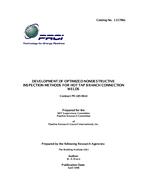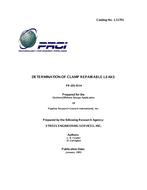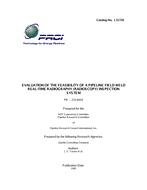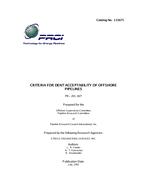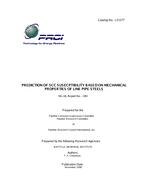Provide PDF Format
PRCI PR-185-9614
- Development of Optimized NDI Methods for Hot Tap Branch Welds
- Report / Survey by Pipeline Research Council International, 01/01/1998
- Publisher: PRCI
$48.00$95.00
L51786e
The Welding Institute (UK)
Need: Following welding, it is desirable to perform a full volumetric inspection of welds made onto inservice pipelines. These welds, which are made for the purpose of installing repair sleeves and branch connections (i.e., hot taps), are particularly susceptible to hydrogen cracking, since fast weld cooling rates result from the ability of the flowing contents to remove heat from the pipe wall. Branch connection welds geometries are not particularly suited to detailed inspection. Surface techniques, such as magnetic particle and liquid penetrant testing, rely on the flaws being at or near the surface, which can be - but is not always - the case with hydrogen cracking. Radiography is difficult due to thickness changes and placement of the radiation source. Ultrasonic inspection is therefore the only option if a full volumetric inspection is required. This is made difficult by the inherent complex geometries, and by the limited access to many of the welds.
Result: In the first two phases of this project, the accuracy and reliability of both conventional and more advanced nondestructive inspection techniques were evaluated by way of a round-robin program of blind inspections The results indicate that there is much variability in the accuracy and reliability of discontinuity detection and sizing depending on details of the NDT procedures adopted, which includes specification of equipment, techniques, calibration methods, and reporting requirements. In Phase III, optimized procedures for sleeve fillet welds and a limited number of branch groove welds were developed in the laboratory using fabricated assemblies containing Intentionally placed discontinuities. In response to a recommendation in Phase Ill, the current phase developed optimized procedures for a wide range of branch groove welds. The results of this phase indicate that the reliability and accuracy of nondestructive inspection techniques is not as high as obtained for sleeve fillet welds in the previous phase of the program In particular, the detection of sub-surface discontinuities by ultrasonic inspection is made more difficult by the added complexity of the branch weld geometries. As with sleeve fillet welds however, the probability of detecting weld toe cracks of a significant size can be quite good.
Benefit: The capabilities and limitations of various NDT methods are presented, and guidance on optimized inspection procedures is provided. If these recommendations are followed, it should ensure that inspections carried out on branch welds made onto in-service pipelines are as effective as possible.
The Welding Institute (UK)
Need: Following welding, it is desirable to perform a full volumetric inspection of welds made onto inservice pipelines. These welds, which are made for the purpose of installing repair sleeves and branch connections (i.e., hot taps), are particularly susceptible to hydrogen cracking, since fast weld cooling rates result from the ability of the flowing contents to remove heat from the pipe wall. Branch connection welds geometries are not particularly suited to detailed inspection. Surface techniques, such as magnetic particle and liquid penetrant testing, rely on the flaws being at or near the surface, which can be - but is not always - the case with hydrogen cracking. Radiography is difficult due to thickness changes and placement of the radiation source. Ultrasonic inspection is therefore the only option if a full volumetric inspection is required. This is made difficult by the inherent complex geometries, and by the limited access to many of the welds.
Result: In the first two phases of this project, the accuracy and reliability of both conventional and more advanced nondestructive inspection techniques were evaluated by way of a round-robin program of blind inspections The results indicate that there is much variability in the accuracy and reliability of discontinuity detection and sizing depending on details of the NDT procedures adopted, which includes specification of equipment, techniques, calibration methods, and reporting requirements. In Phase III, optimized procedures for sleeve fillet welds and a limited number of branch groove welds were developed in the laboratory using fabricated assemblies containing Intentionally placed discontinuities. In response to a recommendation in Phase Ill, the current phase developed optimized procedures for a wide range of branch groove welds. The results of this phase indicate that the reliability and accuracy of nondestructive inspection techniques is not as high as obtained for sleeve fillet welds in the previous phase of the program In particular, the detection of sub-surface discontinuities by ultrasonic inspection is made more difficult by the added complexity of the branch weld geometries. As with sleeve fillet welds however, the probability of detecting weld toe cracks of a significant size can be quite good.
Benefit: The capabilities and limitations of various NDT methods are presented, and guidance on optimized inspection procedures is provided. If these recommendations are followed, it should ensure that inspections carried out on branch welds made onto in-service pipelines are as effective as possible.
Related Products
PRCI PR-231-9419
Evaluation of the Feasibility of a Pipeline Field Weld Real-time Radiography (Radioscopy) Inspection..
$25.00 $49.00
PRCI Report 180
Prediction of SCC Susceptibility Based on Mechanical Properties of Line Pipe Steels..
$125.00 $249.00

